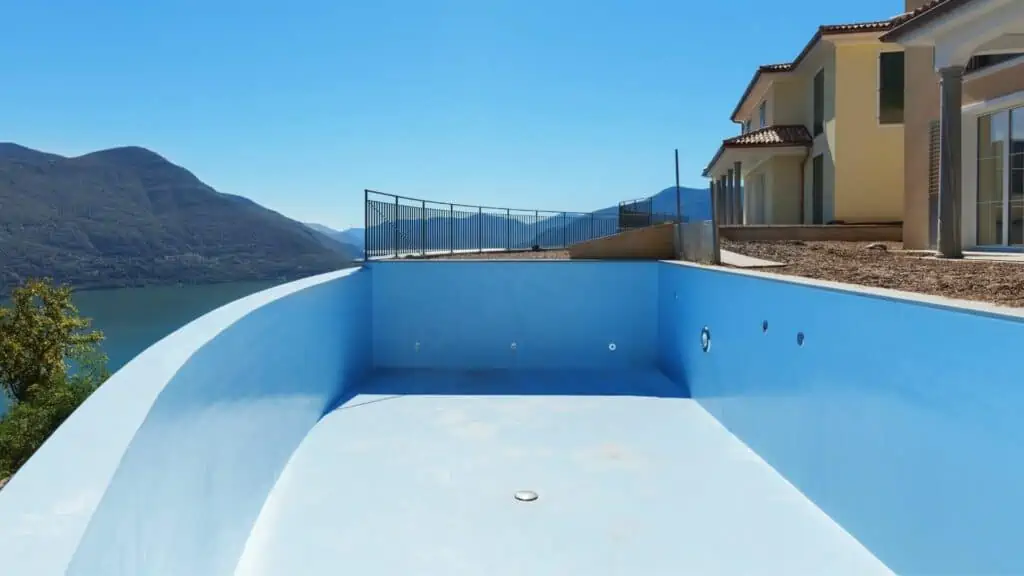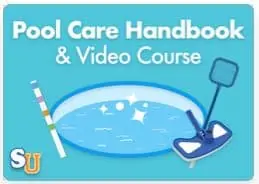Draining a swimming pool is not something you will need to do often, certainly not with an inground pool, and is generally only required in order to repair the structure, to cure a plumbing leak or if you have major contamination.
Draining a pool completely is not without risks to the structure of the pool so you should explore all other avenues before deciding to drain a pool. However, as a pool owner, this is something that will probably need to be done at some point so you should be sure of what you are doing.
If you are unsure then call in a pool professional to undertake the work ad check that they have professional insurance should the pool structure be damaged when they drain it.
Draining an above ground pool is something you will do probably annually for the winter and which has fewer risks. Read my post How to drain an above ground pool for tips on how to do it.
So without any further ado, let’s get started!

Why should I drain my swimming pool?
The truth is, draining your pool can be a daunting task that requires planning and perfect execution, so you might want to think this through as you are going to pump out thousands of gallons of water.
Although most modern swimming pools have an excellent filtration system to keep pools clean and fresh, there can still be a few instances where you have to drain your swimming pool water.
- Pool maintenance is one of the most common reasons for an empty pool. When you have a pool for an extended period, you might eventually notice a few cracks and chips on the pool walls or pool floor that require you to drain your pool so that it can be restored and be as good as new.
- Another factor that requires the whole draining process is the unbalanced water chemistry. Usually, a high concentration of algae disturbs the pool chemicals, which can be controlled when deeply cleaned. The algae can cause discoloration and some severe damage to the concrete pool, vinyl, etc., which sometimes requires manually cleaning the pool walls. The best way you can avoid this hassle is by daily monitoring the water chemistry and concentration of other contaminants efficiently.
- Over time the total dissolved solids (TDS) of your in-ground pool will build up because of residues of chemical products, dirt, and other contaminants. The chemical balance of your pool will be disturbed which also affects the water quality of your pool.
- If you live in a relatively cold climate you will need to at least partially drain your pool when closing an inground pool for the winter
Although the chlorine-neutral water kills most germs or harmful particles, the TDS will eventually require draining your pool and beginning fresh. Therefore, it is recommended you keep track of the TDS level with the help of a meter or test strips and drain water when the TDS is around 25,000 parts per million.
When should I drain my pool water?
As we have already warned you about the hassle of this task, you must keep in mind that this will take a lot of your time and money. So you have to do this as quickly and precisely as possible; make sure you check some of the boxes, if not all:
- We hate to break it to you, but this whole draining process will require big bucks. From home’s sewer cleanouts to draining the pool and cleaning to refilling it with fresh water, all of this requires both hard work and money. So before you drain water from the pool, you must check your budget and make a realistic plan.
- You shouldn’t leave your empty pool sitting for more than a week, unless you are making extensive renovations, so you need to make sure you don’t keep important events/meetings when planning to do a makeover for your pool. The size of the pool will determine the time you will need to clean and restore it.
- Although it might seem like a good idea to drain your pool on a sunny day, it is not ideal as the dry weather can lead to various complications. From damage to the lineage or walls of the pool due to the hot sun leaving cracks on the floor of the pool and other drainage problems occur.
So it is advised not to leave your empty pool when the temperature is 85°F (29°C) or more.
- Before you switch the drain valve of your pool, test the water of your pool to find out its chemical content. Typically, you need to drain the pool water into a sewer system, so you must ensure the water is chlorine neutral. You can use a test strip to check if the pool’s water has a neutral pH level. You can take help from your local water authority to give you exact details about this as well as help you throughout this process.
- Saving you and your pool from making a mess or doing any serious damage is the automatic timer that should be installed in your circulation system. The automatic time shuts down all the elements like sump pumps, garden hoses, and pool lights so that you can avoid the overhead of the pool or pumps. In addition, the automatic timers off prevent any mishappening as it makes sure the system is off when you don’t need it.
How to drain a swimming pool?

After you are done taking all the necessary precautions, it is time to start draining! Here are the 5 easy steps to drain a pool.
Step 1
First things first, switch off the automatic timer so that pumps, pool lights, etc, do not overheat when you start to drain out the pool water.
Step 2
Using the pool pump
Turn off the lines from the pool skimmers and fully open the main drain line. Then run the pool pump with the multiport valve in the waste position. Make sure that the thousands of gallons of pool water runs away somewhere safe (and legal) via a backwash hose. See where to drain the pool water in the section below.
Once the poo is empty, shut off the pool pump as running it dry will burn it out.
Jump to step 5.
Using a submersible pump
When you are planning to drain thousands of gallons of water, a basic pump won’t cut it; you need a submersible pump that you can either buy or rent.
Place the submersible pump at the deep end’s center on the floor, making sure the power cord is long enough to stretch from the bottom of your pool to the power outlet.
A drainage hose needs to be attached to the submersible pump, and you’ll want to position the other end of the this wherever you’re draining all that water. Make sure it goes all the way down; otherwise, you’ll be dealing with thousands of gallons of wasted water.
Step 3
Start the draining process by turning on the submersible pump. Here you will be tempted to leave and let the pump do its job, but unless you want to flood your house or let the wires loose. It is recommended that you stick around to keep an eye on the pump to ensure the whole process is smooth.
Once the water level is so low that the submersible pump can no longer pump any more water you can go ahead and remove it.
Step 4
Next, make sure to open the hydrostatic pressure relief valves (assuming you have them) or the flood gates to avoid creating too much pressure on the underground water.
Step 5
After you are done with draining, move on to making all the repairs you want. Ideally, it shouldn’t take more than a week for you to repair all the damages.
After you’re done with it, you can go right ahead to refill the pool with water by closing off the relief valve and turning on the pump to fill the reservoir with fresh water.
Where to drain the pool water?
As you know, the water of the pool is contaminated with harmful chemicals like chlorine, calcium deposits, alkaline adjusters, etc. So, in many cases, the local water authority will have put restrictions on where to drain the water.
However, if your pool’s water contains a high concentration of chemicals, then you can drain the water into the municipal sewer system, as it also controls your home’s sewer cleanout. Moreover, you should avoid overloading the sewer system and pass the water through slowly.
Furthermore, if your pool is low on harmful elements and holds chemical-neutral water, then you might be able to drain the water into a sewer or even your lawn. However, there are a few things you should avoid while doing this, like running the hose/garden hose into a street unless you have the approval to do some.
Read my post about where to dispose of pool water.
How to prevent a pool pop?

Pool pop is the worst thing that can happen when pool owners drain inground pools. A pool pop is when the bottom layer of your pool comes floating up to the surface, usually due to high pressure or overloading.
As a result, the PVC pipes and the pool shell will crack or separate from the pool’s floor. This can lead to several problems like cracking of concrete decks or damaging the electric wire of the pool light, which can risk the chances of electrocution.
In order to prevent your pool from popping, there are a few precautions that you should take before you start to drain a pool of water:
- When you are trying to drain the water into the sewer cleanout, clearly you must ensure that the garden hose/drainage hose is long enough for it. If you can, run the drainage hose downhill from the pool to avoid any clogging or overflowing of water when you drain the water.
- Your pool experiences pressure on the sides of the pool when there is heavy rain, and groundwater level is high, which increases the risk of pool pop once you start draining water. So, it is better to avoid draining your pool during the rainy season.
- The soil around the pool creates hydrostatic pressure, which can pop the pool off the ground. This is common if you drain the pool after heavy rain. However, the hydrostatic valves save the day. These valves are installed underneath the plaster and are like slotted pipes that help prevent pool pops.
Can you drain a fiberglass pool?

Draining a fiberglass pool can lead to problems as once the water is out it is quite possible for the fiberglass liner to effectively jump out of the ground. This will mean major work to rectify this and put the liner back.
For this reason, it is probably better to get in a pool professional (or even the original pool builder) to drain the pool safely.
Frequently Asked Questions
Do I need to run my pool pump every day?
Yes, to effectively circulate and clean your pool, you should run it for an average of 8 to 10 hours every day.
How long does above ground pool last?
An above-ground pool’s market average life ranges between 7 to 15 years. However, if you purchase a high-quality product and maintain your pool appropriately, above ground pools can last much longer.
What is a good size pool for adults?
A swimming pool that measures 18 feet by 36 feet is generally considered the most suitable pool size for adults.
What is the purpose of a storm drain?
Storm drains collect rainwater runoff from the road and transport it to an outfall.
What is a sump pump & what does it mean?
A sump pump is a pump for the accumulated water from the basement of your home. A sump pump prevents the basement from flooding in case of the overloading of pipes. In addition, you can use a drainage sump pump to drain your pool more quickly.






Leave a Reply